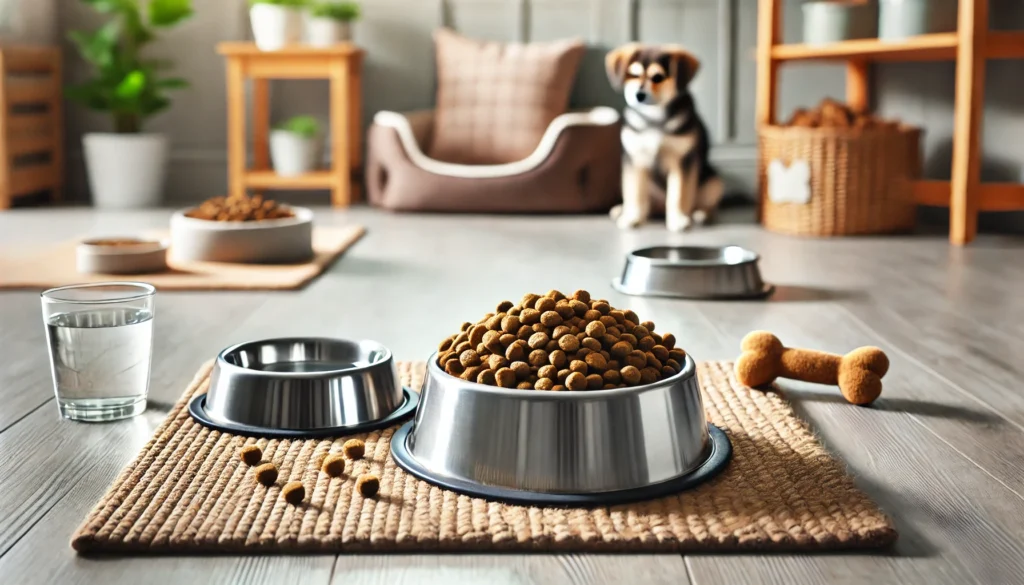A balanced diet is crucial for your dog’s health, energy, and longevity. With so many options on the market, choosing the right diet for your dog can feel overwhelming. This guide will help you understand the nutritional needs of dogs and offer tips to select the best food for their lifestyle, size, and age.
Understanding Your Dog’s Nutritional Needs
Dogs require a balanced mix of proteins, fats, carbohydrates, vitamins, and minerals. Each of these nutrients plays a specific role in maintaining a dog’s health, from muscle development to immune support.
- Protein: Essential for muscle growth and maintenance, protein is a key component in a dog’s diet. Look for animal-based sources like chicken, beef, or fish.
- Fats: Fats are a vital energy source and support skin, coat, and brain health. Healthy fats, like omega-3 and omega-6 fatty acids, are beneficial.
- Carbohydrates: While not strictly necessary, carbohydrates provide additional energy and fibre, aiding digestion.
- Vitamins and Minerals: Dogs need a variety of vitamins and minerals to support their immune system, bone health, and overall well-being.
Dos for Choosing a Balanced Diet
To ensure you’re meeting your dog’s nutritional requirements, follow these recommended practices.
1. Choose a High-Quality Dog Food
High-quality dog foods typically have meat as the primary ingredient, with fewer fillers like corn, soy, or wheat.
- Check the Ingredients: Look for meat or meat meal as the first ingredient. Avoid foods with unnamed meat by-products.
- No Artificial Additives: Opt for foods free from artificial colours, flavours, and preservatives.
- Age-Appropriate Formulas: Choose food that is specifically formulated for your dog’s life stage (puppy, adult, or senior).
2. Match the Diet to Your Dog’s Size and Activity Level
Different breeds and sizes have varying energy requirements, and so does the lifestyle of each dog.
- Small Breeds: Small breeds need calorie-dense foods as they have faster metabolisms.
- Large Breeds: Larger breeds benefit from diets that support joint health and controlled growth, especially when young.
- Active Dogs: High-energy dogs may require diets with additional protein and fat to sustain their activity level.
3. Include Fresh Water at All Times
Hydration is essential for every dog, regardless of diet type. Ensure that fresh water is always available.
- Water Bowls: Use clean bowls and refill daily to encourage your dog to drink.
- Wet Food: For dogs that are less inclined to drink, adding wet food can help increase their water intake.
4. Consider the Benefits of Mixed Feeding
A mix of dry and wet food can offer a balance of textures and nutrients.
- Variety in Diet: Mixing foods can make meals more interesting for your dog.
- Improved Hydration: Adding wet food can contribute to your dog’s daily water intake.
- Oral Health: Dry kibble can help reduce plaque buildup, promoting better dental health.
5. Monitor Your Dog’s Weight and Health
Regular weight checks and vet visits are essential for ensuring your dog’s diet is appropriate.
- Adjust Portion Sizes: Monitor your dog’s weight and adjust food portions accordingly.
- Body Condition Score: Learn to evaluate your dog’s body condition to keep them at a healthy weight.
- Vet Guidance: Consult your vet for dietary recommendations tailored to your dog’s unique health needs.
Don’ts for Choosing Your Dog’s Diet
Avoid these common mistakes when selecting or feeding your dog’s diet.
1. Don’t Feed Table Scraps
Human food can be high in salt, sugar, and ingredients that are toxic to dogs, like chocolate, onions, and garlic.
- Digestive Issues: Table scraps can cause digestive problems and lead to unhealthy weight gain.
- Unsafe Ingredients: Foods like grapes, raisins, and alcohol are toxic to dogs.
- Discourages Begging: Avoiding table scraps also discourages begging behaviours.
2. Avoid Diets with Excessive Fillers
Fillers like corn, soy, and wheat may provide bulk but are often low in essential nutrients.
- Nutrient Density: Look for foods where the primary ingredients are nutrient-rich, such as meats and vegetables.
- Potential Allergies: Some dogs have sensitivities to fillers, leading to skin issues or digestive discomfort.
- Reduced Satiety: Foods high in fillers may not keep your dog feeling full for as long.
3. Don’t Make Sudden Diet Changes
Abruptly switching diets can cause digestive upset, such as vomiting or diarrhoea.
- Gradual Transition: Introduce new food slowly over a week by mixing it with the current food.
- Observe Reactions: Watch for signs of intolerance, like loose stools or decreased appetite.
- Stick to Routine: Dogs thrive on consistency, so avoid frequent changes to their diet.
4. Avoid Overfeeding and Free Feeding
Overfeeding can lead to obesity, which is associated with various health problems, including joint issues and diabetes.
- Portion Control: Measure food portions to prevent overfeeding.
- Scheduled Feedings: Feed at set times rather than leaving food out all day to control calorie intake.
- Use Treats Sparingly: Treats should only make up about 10% of daily caloric intake.
5. Don’t Ignore Signs of Food Sensitivities
Food sensitivities can manifest in symptoms like itching, ear infections, or digestive issues.
- Identify Common Allergens: Ingredients like chicken, dairy, and grains may cause sensitivities in some dogs.
- Hypoallergenic Diets: Hypoallergenic dog foods are formulated to reduce the risk of allergic reactions.
- Consult a Vet: If you suspect a food sensitivity, work with a vet to identify safe ingredients.
Recognising Signs of a Healthy Diet
A well-balanced diet should reflect in your dog’s overall appearance, energy, and behaviour. Look for these signs to confirm that your dog’s diet is meeting their needs:
- Shiny Coat and Healthy Skin: A balanced diet promotes a glossy coat and reduces shedding.
- Bright Eyes and Clean Teeth: Nutrient-rich food supports good oral and eye health.
- High Energy and Playfulness: Healthy dogs are generally energetic and enjoy physical activities.
- Normal Stools: Consistent, firm stools are a good indicator of digestive health.
Conclusion: Feeding Your Dog for Optimal Health
Choosing the ideal diet for your dog doesn’t have to be complicated. By focusing on high-quality ingredients, considering your dog’s age and activity level, and avoiding common pitfalls, you can provide a diet that supports their health, energy, and happiness. Regular vet check-ups and monitoring your dog’s response to their diet will help you adjust as needed, ensuring they thrive at every stage of life.

Meet Claudia Boaski, an enthusiast in pet care, plants, and home wellness. She is dedicated to helping people create harmonious and welcoming homes, fostering a deep connection with nature and their furry companions.







